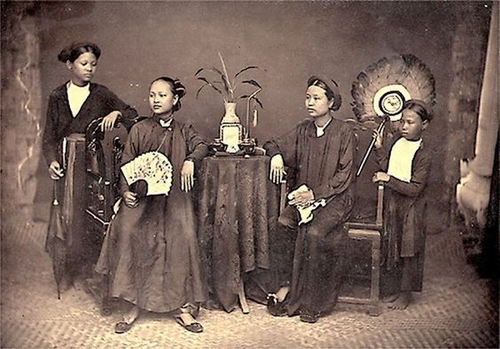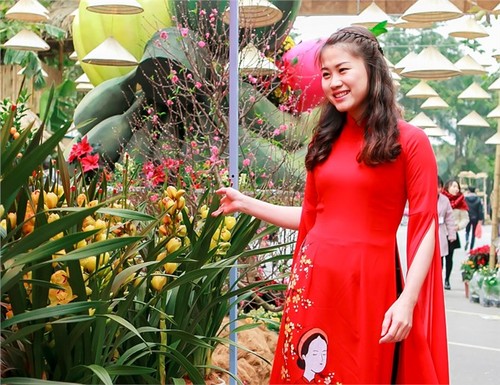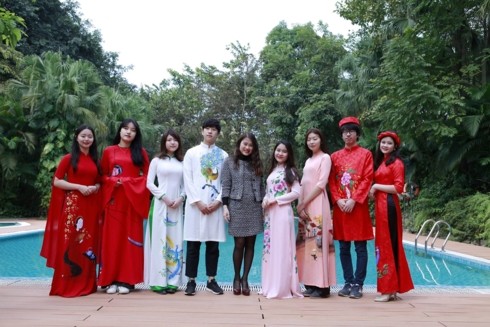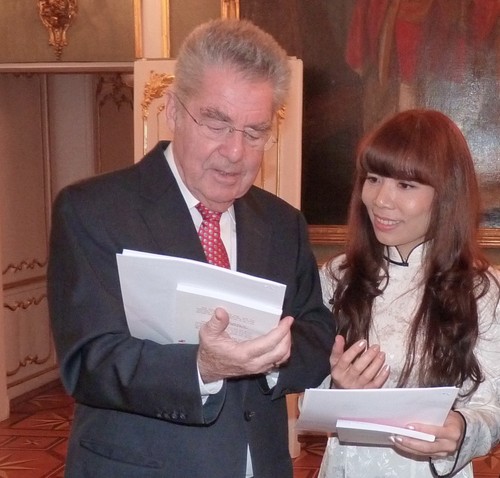"My mother and I were born in Hanoi. Ao dai used to be a compulsory outfit for certain activities, such as going to school. Even street vendors wore a brown ao dai. When Vietnam fought in the wars, ao dai was not used so often. But when wars were over, ao dai returned to its heyday. Every time I see an ao dai, I feel so proud and love Vietnam more."
Ms. Lê Thiếu Ngân, a lecturer of the University of Languages and International Studies said despite the loss of some traditional values, Vietnamese have managed to preserve their dressing style.
Images of “Ao dai” are found on Dong Son bronze drums and other artifacts dating back thousands of years. In the early 20th century, most urban Vietnamese women wore tunics made with five long flps called “áo ngũ thân”, the five flaps reflect the five elements of oriental cosmology: metal, wood, water, fire, and earth.
The “Ao dai” is a tight-fitting silk tunic worn over pantaloons. Although there has never been an official document designating the “ao dai” as the national dress of Vietnamese women, the tunic is worn by Vietnamese women for any important or formal occasion such as a national holiday or a traditional festival. Nowadays, along with the development of the fashion industry, the Ao dai also has been made trendy but retained its original form. There are a wide range of materials one can use to make Ao dai, however, silk is always the most favorable choice.
 In the early 20th century, Ao dai's color were usually dark (Photo: Pinterest) In the early 20th century, Ao dai's color were usually dark (Photo: Pinterest) |
Thanks to the creativity of the fashion designers, modern Ao dai’s can be mixed with jeans, and recently, many brides have chosen Ao Dai as their wedding dress. Designers unleash their own passion and creativity, some try embroidering, some attach jewels. Bui Mai Thuy, an amateur designer who is working as a lecturer of Foreign Trade University, has turned every ao dai into a work of art.
“My designing career with Ao dai was not intentional, with my initial target of making some nice ao dai for my friends, who are foreigners visiting Vietnam. I like painting so I tried to draw patterns on ao dai. When doing so, I feel extremely inspired. That’s why my designs are very different to others. Nowadays, patterns on ao dai are normally printed or embroidered. I draw my own patterns on Ao dai, making them unique.”
 Designer Bui Mai Thuy Designer Bui Mai Thuy |
Unlike mass produced costumes, each design by Thuy is drawn by herself and carries a different story. Thuy’s paintings have been inspired by “Kieu’s tale” of late poet Nguyen Du, Dong Ho paintings, or folk arts. Her popular designs include To nu painting (Virgin girls), Kieu playing pipa strings, and Đông Hồ painting depicting scenes of picking coconuts. Those pictures are originally displayed horizontally, but Thuy has successfully drawn them vertically on Ao dai, with harmonized highlights on the dress’ chest and waist. According to Thuy, drawing on ao dai is different: “Drawing on a piece of cloth is different from drawing on papers or on canvas. When drawing on an ao dai, you can’t stretch the cloth too much otherwise it will be damaged. Therefore, I have to be extra careful and meticulous. Additionally, each picture on ao dai has its own background color so I have to choose painting colors that match the ao dai’s color to create the best design.”
Each ao dai is created according to the wearer’s body shape, style, and taste. Together with Thuy’s passion of folk culture, each ao dai becomes a work of art that showcases the artist’s feelings and the wearer’s personal style. Pham Tuyet Minh, a lecturer of the Foreign Trade University chose an Ao dai design by Thuy to wear in many important occasion, including her PhD thesis defense ceremony. Minh said: “I have seen a lot of Ao dai designs of professional designers. But I like Thuy’s designs because they can show the elegance of Vietnamese women. I like the Virgin Girl design the most. Thuy made it for me without direct measuring of my body, but her product was perfectly fit for me. The cloth Thuy chose was stunning, which made the Ao dai look mild and charming.”
 Bui Mai Thuy and her friends wearing her Ao dai designs Bui Mai Thuy and her friends wearing her Ao dai designs |
Renovating Ao dai has become more and more popular in recent years. To Bui Mai Thuy, renovating must go with keeping traditional features in Ao dai modernization. Her talented drawings inspired by folk paintings from Vietnamese culture turn each Ao dai into an icon of Vietnam's people and culture to international friends.
Ao dai has stood the test of time and shone in today’s life. And when it comes to the world stage, Ao dai becomes more and more symbolic. Dr. Nguyen Thi Bich Yen, representative of Art and Literature newspaper in Austria introduced her ao dai to international friends in a very special way.
“The first time I wear an ao dai in an international event was a meeting of Russian President Vladimir Putin in Austria. My colleagues from the Russian News Agency TASS interviewed me. Afterwards I found out that, thanks to the Ao dai, people at that event knew where I come from. Since then, I understood the importance of the dress, particularly for a journalist working overseas like me,” Yen said.
That day was unforgettable to Yen, she told VOV. After the interview with TASS, she said, a lot of delegates at the event complimented the dress she was wearing and many female colleagues said they want to buy one when they visit Vietnam. Since then, the idea of promoting Ao dai internationally has grown bigger and bigger in Yen’s mind. She thinks wearing ao dai in an international event will not only show your personal beauty, but also honor your home country, and was a wordless statement on your nationality.
“I hope that during the traditional Vietnamese Lunar New Year, when the Vietnamese Embassy in other countries organizes this festival, everyone, including Ambassadors and the guests will wear Vietnamese Ao dai. We do it on one day and all around the globe, it will create a very good impression.”
 Nguyen Thi Bich Yen (R) wearing an Ao dai in an interview with Austrian President Heinz Fischer (Photo: baoquocte.vn) Nguyen Thi Bich Yen (R) wearing an Ao dai in an interview with Austrian President Heinz Fischer (Photo: baoquocte.vn) |
In 2015, with the help of the Vietnamese Embassy in Austria and the local authority, Nguyen Thi Bich Yen and her friends organized the first Vietnamese Day in Austria. The event promoted Ao dai made from Ha Dong silk. She said: “In Austria there are many cultural events of the community, and an event called "Vietnam day" was new. Thanks to the help of Vienna City’s authority and the Vietnamese Embassy in Austria, we successfully organized the event. It featured the Ha Dong Silk show to raise funds for Ha Long city, which was hit by a flood at that time. That event, with an auction to support children in Ha Long and an exhibition displaying Vietnamese fine-art and silk products, attracted more than 3,000 visitors.”
Yen is planning a project to hold an Ancestral Day for Vietnamese communities around the world, and part of it will honor Vietnamese’s ao dai. She said: “I sincerely hope that many people will join us in this project. On March 10 of the Lunar calendar, everyone is encouraged to wear Ao dai when they come to the event to introduce the world to the cultural beauty of Vietnam. Another idea is, at such events, Vietnamese designers, garment manufacturers, as well as fashion industry business people, come and make Ao dai as gifts for everyone. Such activity will create a good impression of Vietnam and its tradition. That’s the ultimate goal of the “Vietnam Ancestral Global Day” project that we are working on.”
This week, we’ve been talking about Ao dai, Vietnam’s traditional long dress and efforts to promote Vietnamese culture to the world. We welcome your feedback at: English section, VOVworld, Voice of Vietnam, 45 Ba Trieu Street, Hanoi, Vietnam. Or you can email us at: englishsection@vov.org.vn. Tune in to our English program on the Internet at vovworld.vn. Good bye. See you next time.